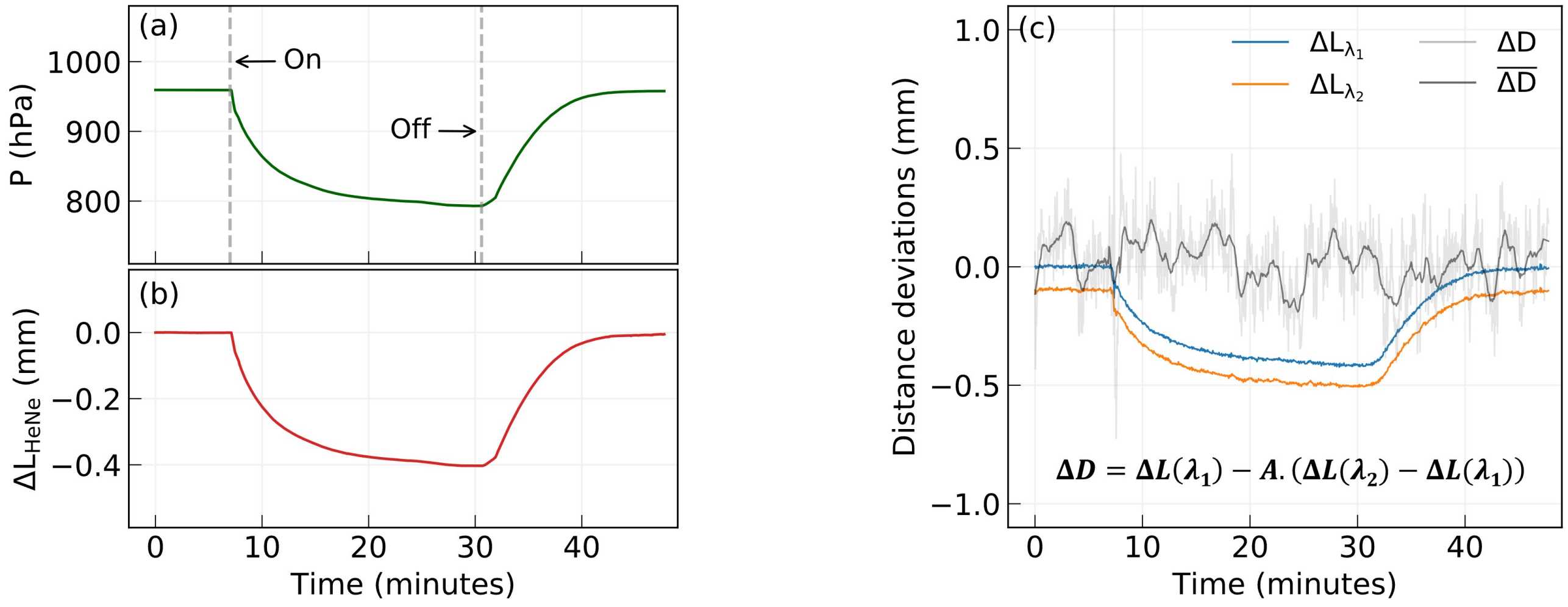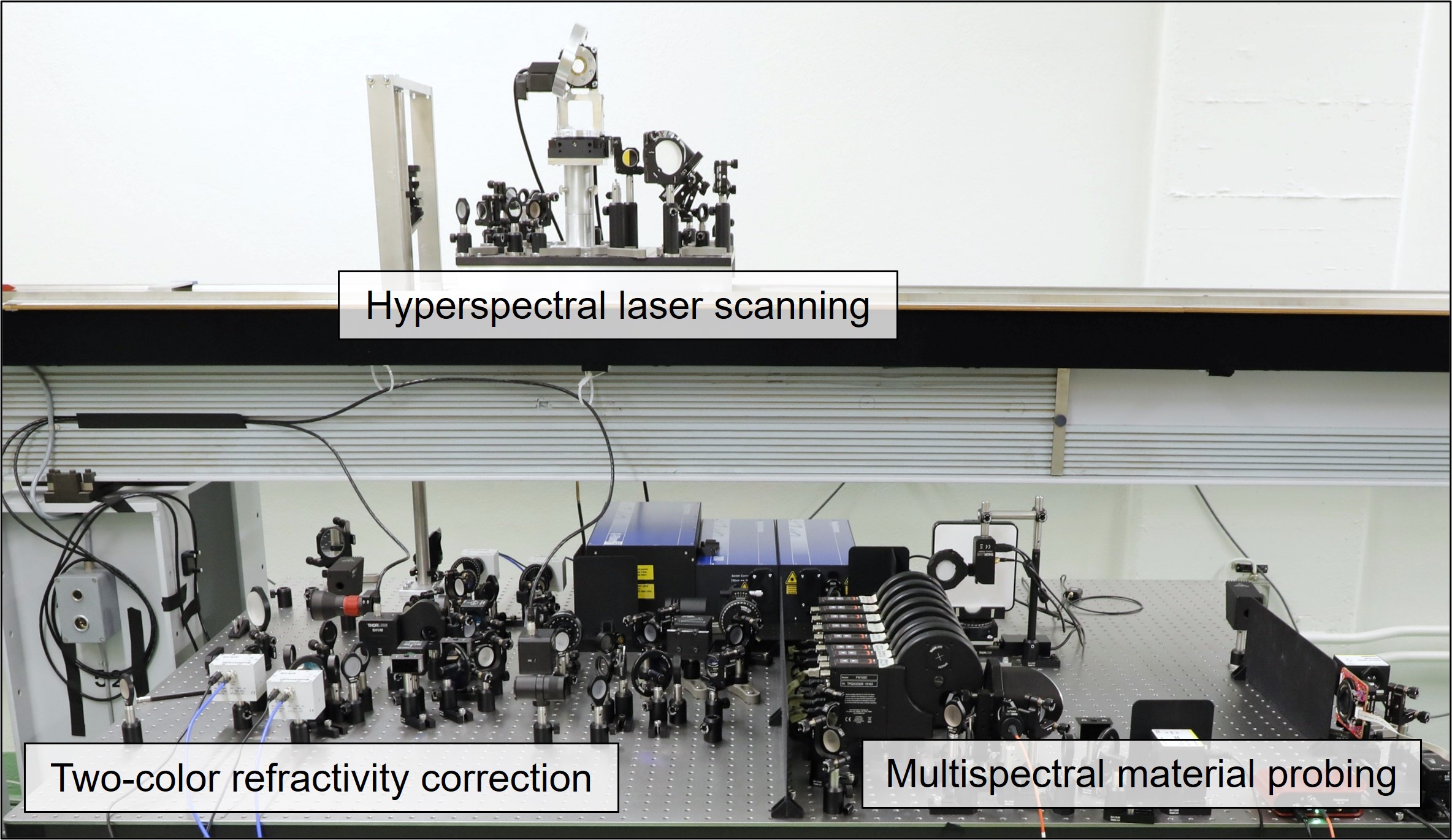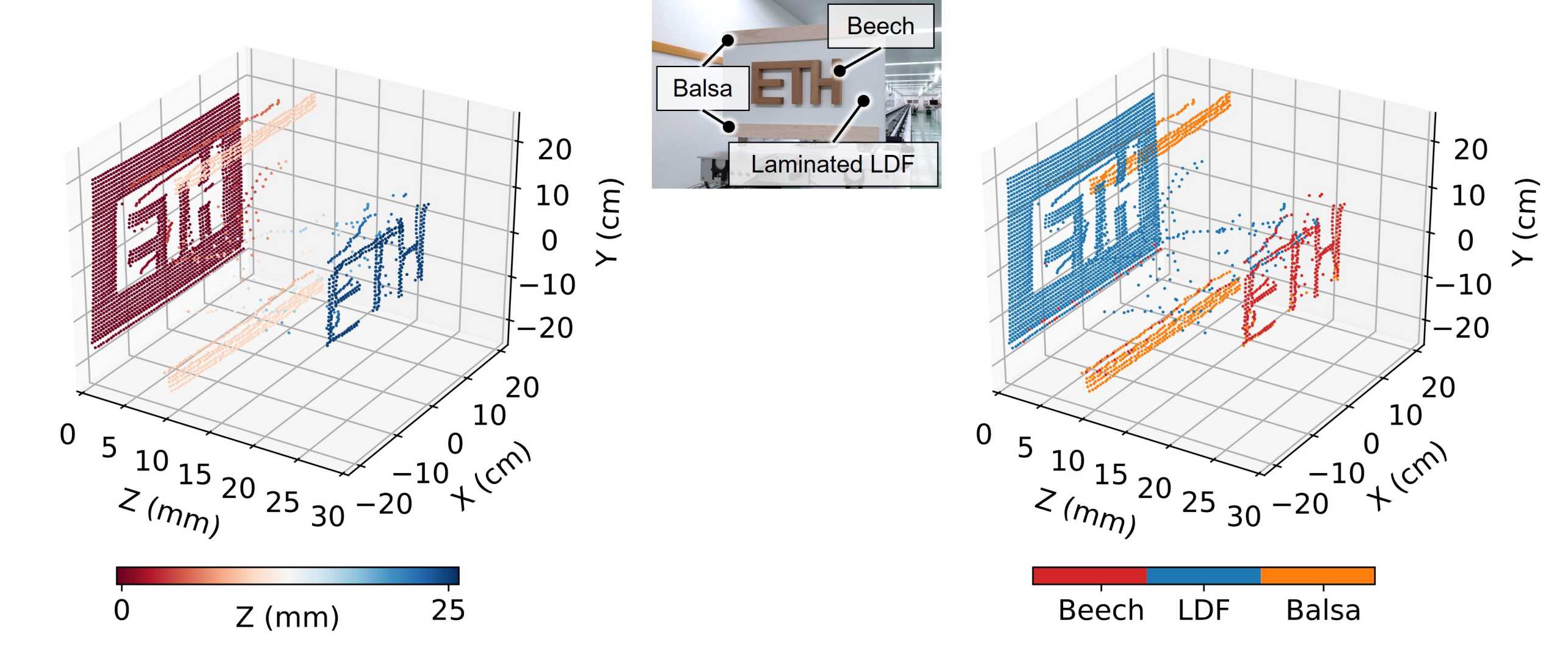Multispectral precision distance metrology and material probing
Recent advances in mode-locked femtosecond (fs) lasers and spectral broadening techniques enable new approaches to multi- or hyperspectral precision metrology. In a Swiss National Science Foundation (SNSF) co-funded project, we demonstrate the application of supercontinuum (SC) sources derived from mode-locked fs lasers for multiwavelength electro-optical distance measurement (EDM) and remote surface material probing.
The SC spectrum covers hundreds of nm as compared to the few tens of nm of the seed mode-locked laser (MLL), thus allowing spectral flexibility for distance measurements over several wavelengths from a single laser source. The repetition-rate of the MLL is locked to an Rb frequency standard, which we also use to establish a common time base for the down-conversion and digitizing electronics. We experimentally investigate the use of intermode beats generated upon direct photodetection of an optically filtered spectrum of the SC for distance measurements. This avoids the need for any optical or electrical modulator and reduces instrumental errors due to crosstalk. Power and delay differences between the spectral ranges can in turn be used to derive information about the propagation media and the remote target.
This investigation may potentially lead to an instrumental basis for future generations of high-precision EDM and LiDAR instruments, which would not only benefit conventional surveying and 3D reality capture but also enable augmented LiiDAR-based material sensing beyond 3D in various application contexts such as automated construction, cultural heritage preservation, circular construction, mining, forest management, and smart agriculture.
Our research has so far demonstrated:
i) Refractivity-corrected distance measurements using two filtered spectral bands of a SC, to achieve highly precise distance measurements over long distances on a cooperative target. (Ref: [5])

ii) Hyperspectral LiDAR for precision laser scanning, indicating the potential to enable finer point cloud segmentation, spectrum-based material classification, and vegetation health monitoring. (Ref: [4, 7]) The precise range information additionally enables improved radiometric correction of backscatter intensity (Ref: [4, 11])
iii) Multimodal multispectral (MM) LiDAR sensing and a specialized feature selection method (Ref: [3, 8])


iv) Augmented classification of material and surface roughness using new polarization-resolved reflectance spectra. (Ref: [6])

List of publications:
Doctoral Theses:
[1] P. Ray, Hyperspectral long-distance metrology using a femtosecond laser supercontinuum, Doctoral Thesis, ETH Zurich (2024), doi:10.3929/ethz-b-000667524
[2] Y. Han, Material probing using multimodal multispectral LiDAR based on a femtosecond laser supercontinuum, Doctoral Thesis, ETH Zurich (2024), doi: 10.3929/ethz-b-000666007
Journal papers:
[3] Y. Han, D. Salido-Monzú, J.A. Butt, S. Schweizer, and A. Wieser, A feature selection method for multimodal multispectral LiDAR sensing, ISPRS Journal of Photogrammetry and Remote Sensing, Vol. 212, pp. 42-57 (2024), doi: 10.1016/j.isprsjprs.2024.04.022
[4] P. Ray, T. Medic, D. Salido-Monzú, and A. Wieser, High-precision hyperspectral laser scanning for improved radiometric correction of backscatter intensity, Optical Engineering, accepted, (2024)
[5] P. Ray, D. Salido-Monzú, R. Presl, J.A. Butt, and A. Wieser, Refractivity corrected distance measurement using the intermode beats derived from a supercontinuum, Optics Express, Vol. 32, Issue 7, pp. 12667-12681 (2024), doi:10.1364/OE.514997
[6] Y. Han, D. Salido-Monzú, and A. Wieser, Classification of material and surface roughness using polarimetric multispectral LiDAR, Optical Engineering, Vol. 62, Issue 11, 114104 (2023), doi: 10.1117/1.OE.62.11.114104
[7] P. Ray, D. Salido-Monzú, S.L. Camenzind, and A. Wieser, Supercontinuum-based hyperspectral LiDAR for precision laser scanning, Optics Express, Vol.31, Issue 20, pp. 33486-33499 (2023), doi:10.1364/OE.498576
[8] Y. Han, D. Salido-Monzú, and A. Wieser, Comb-based multispectral LiDAR providing reflectance and distance spectra, Optics Express, Vol. 30, Issue 23, pp. 42362-42375 (2022), doi: 10.1364/OE.473466
[9] P. Ray, D. Salido-Monzú, and A. Wieser, High-precision intermode beating electro-optic
distance measurement for mitigation of atmospheric delays, Journal of Applied Geodesy,
Vol. 17, Issue 2, pp. 93-101 (2023), doi:10.1515/jag-2022-0039
Conference papers:
[10] Y. Han, D. Salido-Monzú, and A. Wieser, "Classification of material and surface roughness using polarimetric multispectral LiDAR," in Multimodal Sensing and Artificial Intelligence: Technologies and Applications III, 12621, 12621D, SPIE (2023).
[11] P. Ray, D. Salido-Monzú, A. Wieser, and T. Medic, Supercontinuum-based hyperspectral laser scanning: towards enhanced 3d surface reconstruction and its benefits for remote sensing, Multimodal Sensing and Artificial Intelligence: Technologies and Applications III, Vol. 12621 (2023)
[12] Y. Han, D. Salido-Monzú, J.A. Butt, and A. Wieser, Polarimetric femtosecond-laser LiDAR for multispectral material probing, Optics and Photonics for Advanced Dimensional Metrology II, Vol 12137 (2022)
[13] Y. Han, D. Salido-Monzú, and A. Wieser, Delay-Augmented Spectrometry for Target Classification Using a Frequency-Comb LiDAR, CLEO: Science and Innovations, SF2F. 5 (2022)
[14] P. Ray, D. Salido-Monzú, and A. Wieser, High-precision intermode beating EDM for mitigation of atmospheric delays, 5th Joint International Symposium on Deformation Monitoring -JISDM (2022)
Contact
- Location location_onHIL D 47.2
- Phone phone+41 44 633 05 55
- Emailemailandreas.wieser@geod.baug.ethz.ch
- contactsvCard Download
Geosensorik und Ingenieurgeodäsie
Stefano-Franscini-Platz 5
8093
Zürich
Switzerland


